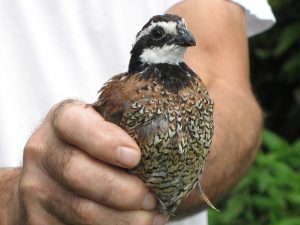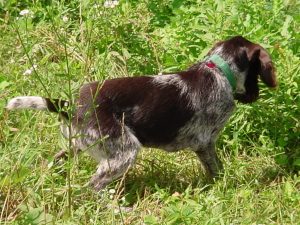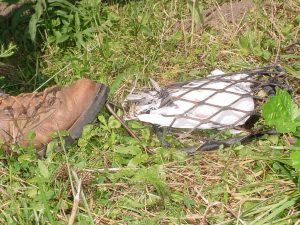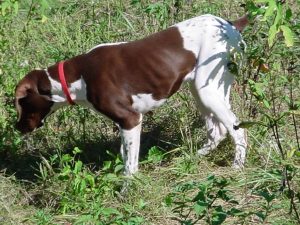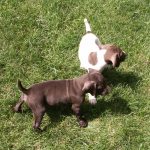POINTING DOG POINTERS: Starting the Pointing Dog Pup – Introduction to Birds
By Bob and Jody Iler
Now that you’ve started your new pointing dog pup out on the “right foot” during those early months, you’re probably champing at the bit to get going on the “real” bird dog training! But where and how to begin? Do you work on handling your pup in the field? Or do you start with some obedience and control training? What about the gun? Or, as our title suggests – do you begin with introduction to birds?
Your new pup is going to tell you how to proceed with this next phase of his training. Is he fairly soft and biddable? Is he headstrong and thick-skinned? Does he shy at new experiences? The point here is to know your pup as you would a child; by getting a good read on his temperament and watching how pup reacts each step of the way, you will know whether you are pushing him too fast.
The started dog program will include bird, field, and yard (obedience) work, plus teaching control work and development to the gun. All of these elements are incorporated into the training in a logical step-by-step manner – but only as our pup lets us know he is ready for each level.
Birds, of course, are the most important part of the training. Without learning to love the birds, the rest of the program is a moot point. Love the birds, you say? Isn’t a pointing dog born loving the birds? Well, yes, that love should run in his bloodstream – but it’s up to you to make sure you bring it out properly! This means introduction to birds in such a way that he won’t feel scared or threatened, but instead will be encouraged to find, point, and chase those birds.
Bird Introduction
The bird field we use to start a young pup in should have low, easy-to-negotiate cover – enough to hide a bird in, but not so dense that it makes it difficult for pup to find the bird. We’ll also let our young pup drag a lightweight 15-20’ checkcord fastened to a flat, snug-fitting collar. At this early stage of bird introduction, we’ll use the checkcord as little as possible – only as needed. With soft or timid pups, we may omit the checkcord at the beginning. We want everything to be positive and don’t want to intimidate softer types. On the other hand, if your pup is bold and headstrong, the checkcord will be your necessary means of control. We’ll devote time to field and control work in our next column.
Quail are ideal for starting young pups. Because we don’t want the quail to whirr up noisily in front of a pup, we start by gently hobbling the quail – tying first its wings together and then its legs together with ties made of soft, sweatshirt-type material. We hide a couple of quail separately in some low cover that will make it fairly easy for pup to find them.
Starting out for the first time in the field, initially pup is not going to recognize the scent of the quail and may even pass it by, but don’t worry. Pup will likely come right back to the bird and nose it out of curiosity. This is when you’ll quickly untie only the legs of the quail, tease the pup with it, and then let the quail run – with pup chasing after it as you praise him! If the pup is very excited, he may even catch the quail. Then you can gently grab it from the pup and untie the wings as well, letting it go again in front of pup. As he chases it, the quail will fly.
If all goes well, you can go on to the second quail and repeat the lesson. If the experience has been positive, the next time you go into the field, if the wind is right and coming toward the pup, he is going to recognize the scent of the bird. You’ll notice right away when he does – and he may even point. We don’t worry about point right now, though. Our main purpose is to get the pup very excited about the birds as he learns their scent, finding and chasing them.
Right here, at the very beginning, is where we must start to read our pup. If he backs away from that first quail, or gives it a wide berth – acting uncertain – he is giving us a cue to go slow. We try to tease the pup and whet his enthusiasm with the hobbled quail and excitedly give lots of praise. By letting the quail run, we encourage the pup to chase, but letting the quail fly too soon if the pup is somewhat shy may scare the pup. The first lesson may simply be introducing pup to the hobbled quail and trying to drum up his enthusiasm. At the very least he has learned the scent of the quail and will recognize it the second time out. If possible, always quit on the most positive reaction from the pup during this phase.
We don’t use pigeons for this initial introduction to birds. We like to get the pup turned on to quail and their gamey scent first. Also, quail are smaller birds and less apt to intimidate pups. When flying, they will sometimes come down again in the field and offer another chance for the pup to find them. Pigeons, when released, will make a lot of noisy flapping and be up and away quickly. This is all right as training progresses, but not initially.
Once the pup is excited about finding and chasing the quail, we can plant the quail unhobbled in the field cover, using either the dizzying method or by disorienting them with the burlap sack method. Both ways work well with quail and simulate natural conditions – always best for training.
With young pups starting their bird work, we’ll often progress to metal traps, using pigeons if all has gone well with the quail introduction. Our steel mesh traps will easily contain a pigeon or chukar, ensuring that the bird will be there for the pup to find as he heads out into the field. We only use the traps at this early stage of bird work, and we wait to use them until we know our pup is excited about and chasing birds. The trap has a “foot handle” that can be stepped on to release the bird so it can fly away. If pup is excited and finds the trap quickly and doesn’t point, he may jump right on top of it. This is all right in the early stages, but we don’t want this to become a habit.
At this time, we are not concerned with staunch points or manners – this is the time to develop the bird crazy attitude in our pup. Within a few weeks you’ll see your pup learning to hunt, using his nose to make scent, flash pointing or even more, and chasing birds with enthusiasm. If he’s doing these things, you’ve successfully introduced your pup to birds and bird work!
Pointing Dog Pointers features monthly training tips by Bob and Jody Iler, who own Green Valley Kennels in Dubuque, Iowa. Bob and Jody have trained pointing dogs for over 35 years and have written many articles for Pointing Dog Journal.



